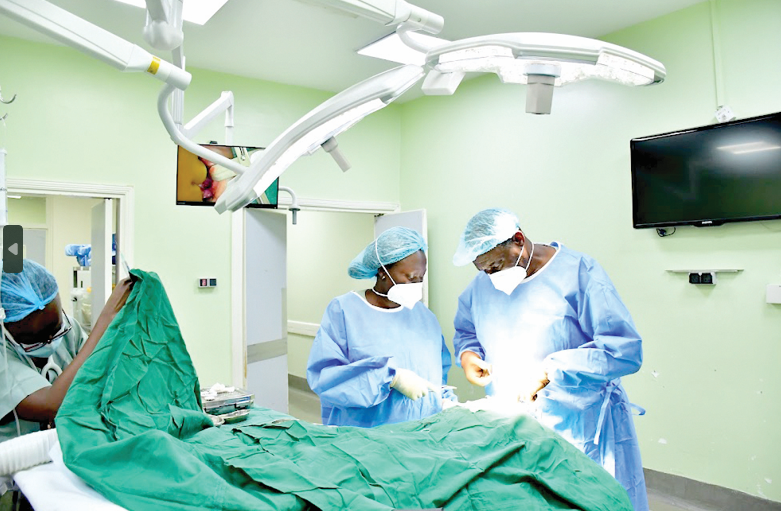Cleft lip and nutrition double burden for Kenyan mothers

Catherine Mwende sits patiently waiting at the Nairobi Hospital, Nairobi County, as the nurses at the facility examine her son, in preparation for a surgery that will change his life.
Her son lets out a fail cry as he is put on the weighing scale by the nurses to measure his weight-an essential part of nutritional assessment before the surgery.
After a few checks on his lips, Mwende joins other host of parents who had travelled several kilometres to benefit from a free cleft lip and palate screening and surgery at the hospital.
Mwende, a resident of Huruma slums, Nairobi, gave birth in June 2022 only to find that her baby had a cleft condition. “During the entire pregnancy, I didn’t have any complications whatsoever. I went to a local dispensary for monthly check-ups. I did not know the child I had in my womb was different,” she begins our conversation.
Mwende would later be discharged from hospital and returned home with love and hope for her son’s future. But their biggest worry was what others would say when they came home to celebrate the birth of a new baby in the family. Her son is now five months and two weeks old. “I am happy my immediate family and the community supported us during the hard times.
However, despite being accepted by her community and family, Mwende would soon begin facing life-threatening obstacles.
A cleft lip, Dr Meshach Ong’uti, a reconstructive and maxillofacial surgeon consultant explains, is a split in the upper lip, and a cleft palate, a split in the roof of the mouth formed if the tissue doesn’t fuse together in the way it should during the fourth to seventh week of pregnancy.
A child could have one or the other -or both. Globally, one in 700 children is born with cleft lip or palate. In Kenya, it is estimated that one in every 500 Kenyan babies is born with a cleft lip or cleft palate according to Operation Smile Mission, a charity that facilitates free surgeries for children with such conditions.
Dr Ong’uti notes that the resulting facial deformity is devastating not only for the infant, but also for the affected family(s) adding that some of them do not survive as a result of malnourishment when they don’t receive timely medical intervention.
“The baby’s face or lips forms between the first four to six weeks of life. The face and its structures develop in the first four weeks of intrauterine life and at this point most teenagers do not realise whether they are pregnant,” Dr Ong’uti explains.
Mwende’s son had what doctors termed as a bilateral cleft lip/palate, a situation where a cleft is on both sides of the lip and palate.
Due to the severity of her baby’s cleft lip, breastfeeding became impossible, and Mwende said that she would stay up all night crying, because she could not feed her baby.
But at times, when Mwende’s milk would flow-it would overwhelm her son’s mouth and almost choke him. She grew more and more worried about his weight.
Although she was nearly overwhelmed with fear and uncertainty, Mwende refused to give up.
Specialised feeding bottle
Luckily, a friend who had a son with a cleft condition gave her a specialised bottle for pumped breast milk or formula made specifically for children with clefts, to avoid feeding with a cup and a spoon.
She also gave his son formula to supplement breast milk, because she was having trouble pumping her own breast milk.
“I pressed milk for one week.Then the second week my breast-milk had dried up. No milk came out for days. Since we could not regularly afford formula milk, we resorted to supplementing his feeding with packet milk. It was a big challenge,” narrates Mwende as her husband cajoles the baby.
She notes that feeding the baby a water-based substitute from a bottle not only did place an unexpected financial burden on the family, but it also put him at risk of not obtaining the proper nutrition he would have received had she been able to breastfeed him.
Dr Ong’uti adds that difficulty in feeding is common among children born with cleft conditions and can lead to life-threatening malnutrition.
Impaired speech, frequent infections, psychological trauma are some side effects of clefts, the doctor notes. “This kind of children are not exposed to the other children hence there is high rates of stigma,” he discloses.
According to the Centre for Diseases Control and Prevention, the actual causes of cleft lip and palate remain largely unknown. However, Dr Ong’uti says there are certain risk factors that predisposes preconception and expectant mothers to have babies with cleft lip and palate.
“The deformity can also arise from cigarette smoking, alcohol and the use of certain substances by pregnant women. Working or living near waste sites, mines, smelters, exposure to chemicals and certain pesticides can increase the risk of an expectant mother having a baby with congenital anomalies,” he says.
Failure of pregnant mothers to take folic acid supplement, and other micro-nutrients during pregnancy period are also to blame to some extent.
Ideally, children are introduced to solid food at six months. But parents of children with clefts might start this sooner, because they are worried about the child achieving normal growth milestones.
Stigma, misinformation, trauma
For Mwende, it hasn’t been easy; “People who see my son for the first time always ask whether he is growing or how much he weighs. Some people in the community think it’s a curse.”
This is common in Kenya. Women are often irrationally blamed when a child is born with orofacial clefts. But Dr Ong’uti notes that such misinformation and stigma should be debunked. “The community needs to realise these children are normal. The earlier we conduct medical intervention the better,”explains Dr Ong’uti.
Another mother that faced stigma and discrimination because of her son’s cleft condition was Hellen Chebeyegon, 22, who had travelled all the way from Ndurumo village, Rumuruti in Laikipia County to attend the screening.
After her son Bravin Mosin’s birth, rumours swirled about the role she played in the formation of his cleft. Villagers said it was as a result of her genes, others said she was cursed.“I had a normal birth. But I didn’t know I was carrying that kind of a child in my womb. Most people in my village think that it was a curse. But I always tell them my God had a purpose for giving me this child,” Chebyegon narrates.
Bravin is one and half years old now.
Specialised nutrition support
Nutrition-related factors contribute to almost half of all deaths of children under five globally. The problem is heightened for children with clefts.
Lilian Abunili, clinical nutritionist at Nairobi Hospital says that babies with clefts need heightened nutritional support in order to ensure they are healthy and able to undergo surgery to fix their cleft safely.
Abunili explains that babies from zero to six months old need exclusive breast feeding to grow optimally. However, they are, especially vulnerable to malnutrition, because the condition makes it difficult to breastfeed, she adds.
Children with clefts cannot develop suckling reflex, they struggle with cleft lip, because the mouth cannot close to hold the mothers nipple compared to a normal child. “We help mothers navigate the process of feeding their babies before surgery. The support, include showing them special tactics to use while breastfeeding to ensure the baby can get the milk, positioning the nipple to the part of the child’s mouth not impacted by the cleft or having the child sit upright while feeding,” notes Abunili.
“For those who can afford we advise them to feed their babies on formula and as they grow they can move to soft foods, such as mashed potatoes, vegetable, broth or soup to make it more nutritious,” she adds.
Costly surgery
Dr Ong’uti says that cleft conditions can be fixed through surgery. He explains that surgery can restore both the function and appearance of those living with cleft,while other services, such as speech therapy,and orthodontic treatment might also be needed.
The cost of reconstructive surgery for cleft lip and palate ranges between Sh150,000-350,000,but that excludes patient reviews, adds Dr Ong’uti.
Unfortunately, cleft lip or palate affects communities that are socio-economically disadvantaged and any residents, such as Chebyegon rely on such free medical camp.
Within Kenya, a series of hospitals provide these surgeries for free for families who might otherwise not be able to afford them through partnership with the international charities such as Help a Child Face Tomorrow.
Dr Ong’uti notes that there is a shortage of Reconstructive and Maxillofacial surgeons properly trained to carry out successful cleft surgeries to avoid multiple repeat operations. There is also low awareness of the availability of the reconstructive surgery service making it difficult for many to access care. “We are able to manage this condition locally, but need support because of the high cost to be able to move from one location to another to clear the backlog of these cases,” he says in ending.












